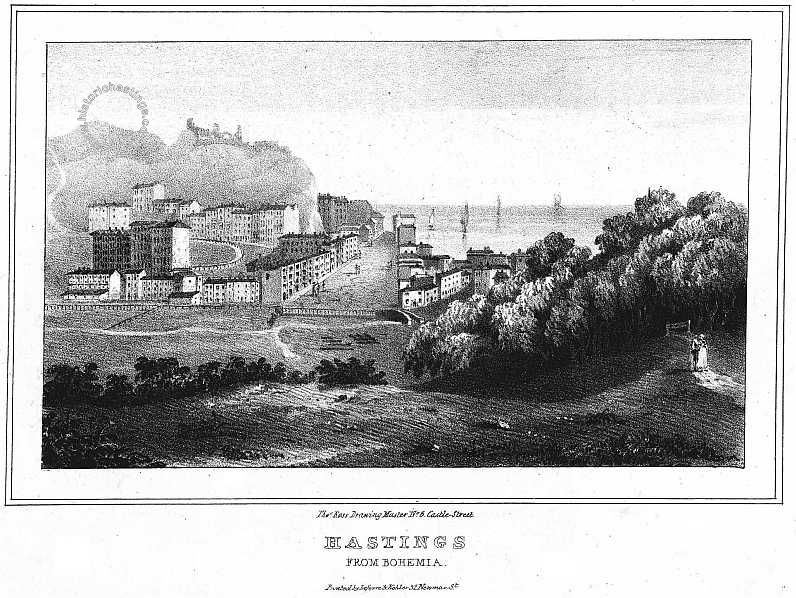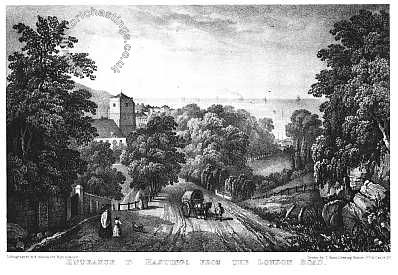
Above “Hastings from Bohemia” The Priory Bridge, later the site of the Memorial is in the centre of the picture with The York Hotel and York Buildings to its left Wellington Square is almost complete. The Priory stream, running left from the bridge, marked the western boundary of Hastings at that time.
We know that Thomas Ross, five times Mayor of Hastings, produced 13 editions of his Hastings and St Leonards Guide between 1835 and 1863. The earlier editions of the guide were somewhat sparsely illustrated which seems strange bearing in mind Ross was also a drawing master. It then emerges that Ross also published a volume of engravings entitled “17 Views of Hastings and its Environs” based on his own drawings, most of which had already appeared singly in his early guide books but included all 7 from the 6th edition and thus offering him the opportunity for selling an additional publication. A more important volume was a selection of 10 lithographs “Ross’s Views of Hastings and St.Leonards”. -undated but no later than 1849 because they all show Ross at 6 Castle Street (he moved from there to Claremont in 1849). It is mostly from this edition that our illustrations have been selected.
In Ross’ day printing of text would be letterpress, relief printing from moveable, re-usable type with illustrations being produced by specialist printers because they required different technologies. Engraving, woodcut, lithography and etching were the main methods of making prints before the invention of photography. To make an engraving, a plate, usually of copper, is cut with a sharp gouging tool and the plate is put in a press and ink rolled onto it. Because copper is a soft metal the number of prints was limited which led to the development of engraving on steel. Zinc and galvanized steel were also used as were hardwoods such as box. The ink is retained in the cuts and transferred to the paper, the opposite of letterpress and woodcut where the raised surface carries the ink. A woodcut is a print produced from a wooden block where areas to be left blank on the paper are cut away from the surface of the wood; the lines left in the relief on the block are inked, and leave a mark on the paper when they are printed and must not be confused with wood engraving. Lithography is based on the antipathy of water and grease. The desired design is drawn with a greasy chalk on to a thick slab of stone. The stone is then wetted, and the water covers only the areas where there is no grease. A greasy ink is then applied to the stone with a roller; the ink is attracted to the already greasy areas, but does not adhere to the wet ones. Paper is then applied to the slab and the design which is now inked is transferred to it. Lithography was quicker and cheaper than engraving but not practical for long print-runs. Etching is the process where the printing plate is covered in varnish. The design is scratched through with a needle. Acid is applied and it eats into the exposed metal, but does not affect the covered areas and the design is etched onto the plate. The varnish is removed, and the plate inked for transfer to paper. The longer the acid is applied, the deeper the lines are etched. Lines can be cut directly into the metal with a needle, a process known as drypoint.



Left All Saints Church and 'The Wilderness'
Above “Hastings from the White Rock” notice The White Rock Brewery on the left, Wellington Square in the centre and Pelham Crescent towards the right. The White Rock is yet to be cut away.
Below “Marine Parade, Hastings” notice the buildings in front of Pelham Crescent, they were to last until Sydney Little removed them for his seafront improvements in the 1930s.
Below left “Ore Church, near Hastings” this ancient church was replaced in the 1860s with the nearby Ore Church on the Ridge. Much of the stone was reused in the new church which is why the old church is now a ruin.
Below “Hastings Castle” the area around Wellington square is now starting to fill up.





Left “Marina, St Leonards” St Leonards Parish Church, destroyed by a flying bomb in the last war is on the left, Crown House can be seen as can The Royal Victoria Hotel with the baths and library in front of it.
Below Left "Entrance to Hastings from the London Road (now Old London Road) with All Saints on the left - before the turnpike created a shortcut
Below “St Leonards, from the pleasure gardens” the area is little changed today.

